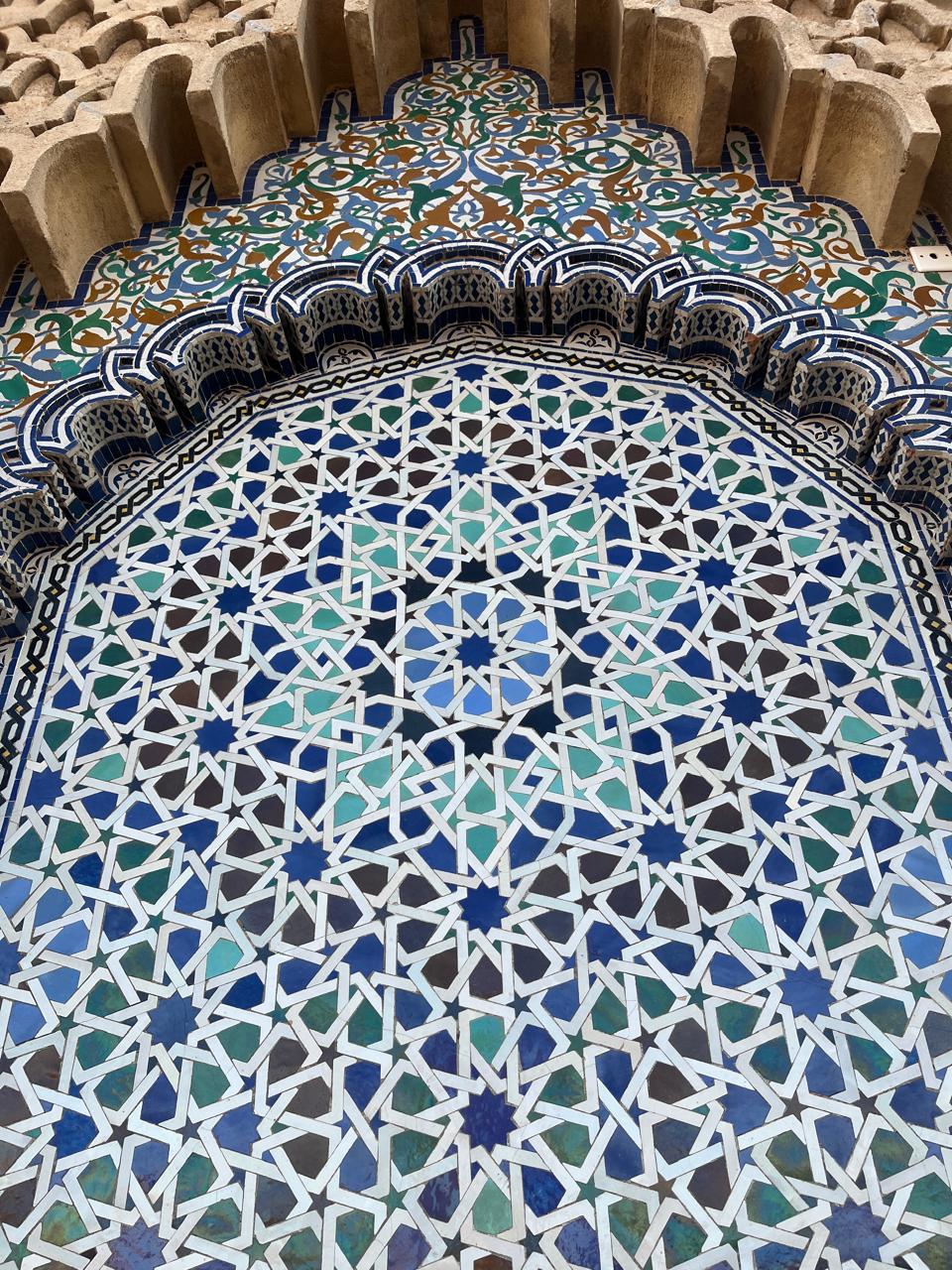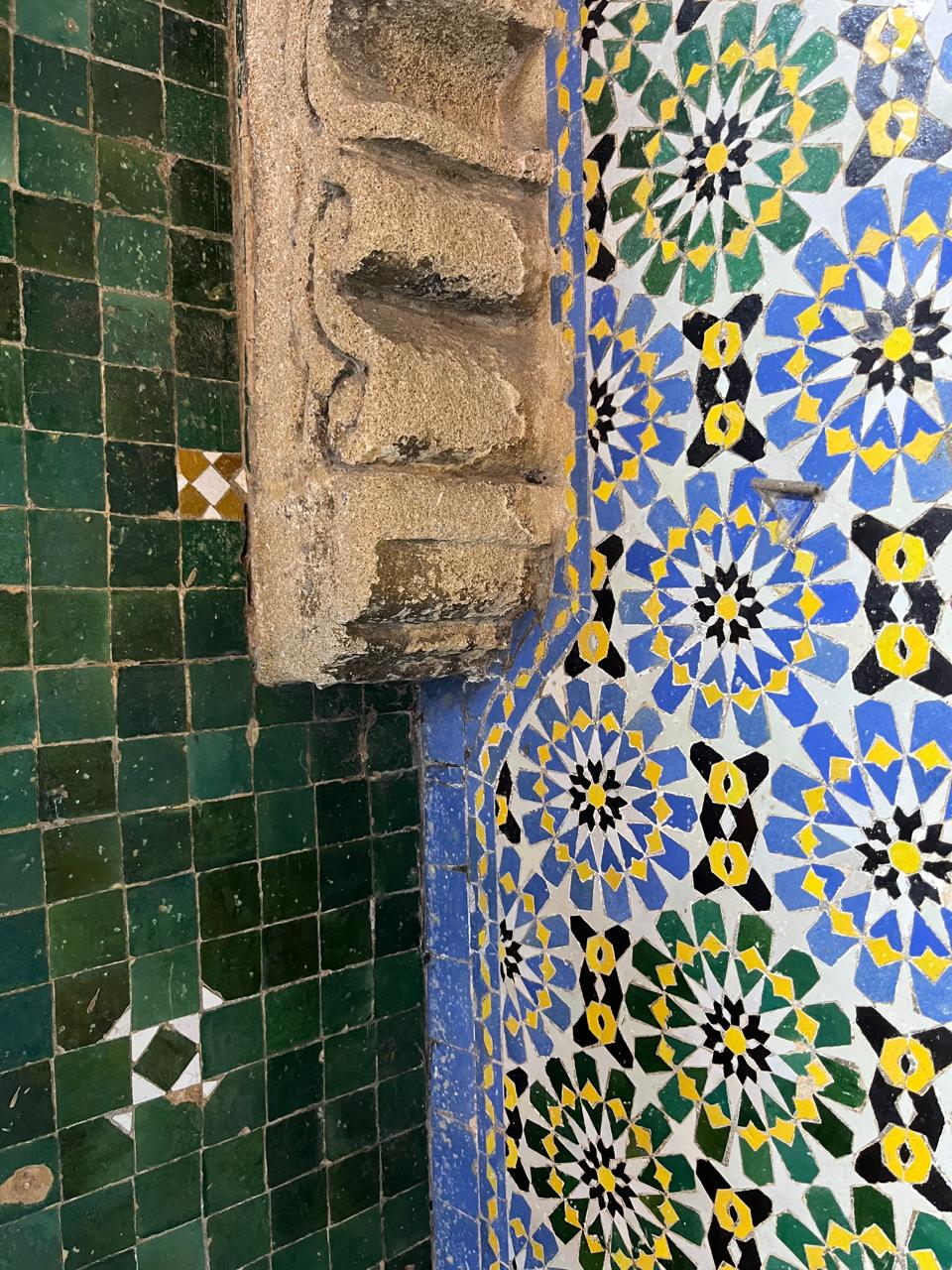- Zellige, a decorative technique of glazed terracotta mosaics,is one of the oldest artistic tradictions in the Arabt World.
- Originating in Morocco , this technique quickly spread throughout the Arab-Muslim world and evolved over the centuries.
the origins of Zellige date back to the 10th century,during the time of the Berber Zenata dynasty,who introduced this mosaic tchnique
to the Fez region of northern Morocco, The Zenata used zellige to decorate their palaces and mosques,and the technique quickly spread throughout Morocco
and neighborig countries.over the centuries ,zellige evolved into a sophisticated and highly stylized decorative art. Craftsmen perfected their
manufacturing techniques,using finer materials and creating more complex and elaborate designs.
In Morocco,Zellige became an integral part of islamic architecture used to decorate walls,ceilings,fountains,and basins in places,gardens,and mosques.
Traditional zellige motifs were often based on geometric shapes and arabesques,but artisans also incorporated floral motifs,animals,and calligraphic
inscriptions into their creations.
- 10th century: The origins of Zellige
Zellige,a decorative technique using ceramic tiles,originated in Morocco,where it first appeared
in the 10th century,probably in the city of Fez. At that time,ceramics were already very present in Islamic art,but Zellige introduced a major innovation:
the ability to create highly complex geometric patterns by assembling tiles of different shapes and colors.
- The First Zelliges were rather simple and consisted of small square pieces of white or beige caramic. There classically shaped tiles were cut into
small cubes called "Zelliges"and assembled to form simple geometric paternes. The zelliges were handmade and fired in wood-fired kils,which gave
them a characteristic reddish color.
-14th Century: Perfection of the Zellige Technique
In the 14th Century, zellige experienced remarkable development under the Mirinid dynasty in Morocco. Craftsmen perfected the technique
by using more varied colors,creating increasingly complex paterns,and incorporating different shapes such as hexagons,stars, and diamonds.
It was during this period that the technique of double-firing clay tiles was discovered,as well as the use of polychrome glazes.Zellige thus
became a highly prized decorative element for palaces, mosques, and mausolems,giving it an important place in Islamic archetecture.
The Marinids also elevated zellige to an art form,viewing it as an expression of their cultural identity.The tiles were handmade by skilled artisans
who knew how to blend colors and textures to create complex and harmonious patterns. The Marinids also introduced new tchniques, such
as cutting zelliges into more intricate shapes,which allowed for more elaborate designs.
The most commonly used motifs during this period were stars, flowers,and complex geometric patterns.Colors ranged from white,black, and green to
yellow,red, and blue,creating a vibrant and varied color palette.Zellige was used to adorn walls,floors, fountains,and pools.
 -16th Century: The Heyday of Zellige
-16th Century: The Heyday of Zellige
In the 16th century,zellige reached its peak under the Saadian dynasty in Morocco.The Saadians were known for thein love of art and architecture,and their use of zellige
in the decoration of sovereign tombs and religious buildings was particularly remerkable.
The tombs of the Saadian rulers were adorned with intricateand colorful Zelliges,creating impressive geometric patterns.
The Saadian Dynasty tomb in Marrakech, which houses the remains of sereval members of the Dynasty,is a famous example of the use of zellige in funerary decoration,
-Zellige was also used to adorn the walls and floors of religious buildings,creating patterns that reflected divine perfection.Mosques,Madrasas,and zawias were decorated
with intricate and colorful zelliges ,creating and atmosphere of peace and serenity conductive to meditation.
The Saadians also introduced new tchniques for zelliges,such as the use oof wooden molds to mass-produce complex patterns.
This allowed for faster and more efficient production of zelliges , which were used in the construction of many buildings,including palaces and fortifications.
The colors used for zelliges in the 16th century were more varied than ever.warm colors like red ,yellow ,and orange were particularly popular,as were cooler colors like
blue, green , and white . Geometric patterns were still very popular, but zelliges were also decorated with floral motifs and calligraphy.
-The 16th century was a period of great creativity and refinement for zellige.Under The Saadian dynasty , Zellige was used extensively to decorate the tombs of rulers
and religious buildings , reflecting the importance of religion and culture in Morocco society at the time . Manufacturing techniques were refined to create even more
complex patterns,and the colors used were more varied than ever.Zellige bacame a key element of Moroccan art and archetecture , and its influence can still be seen
in the Moroccan urban lanscape today.
-17th and 18th Centuries : Zellige's Decline
-In the 17th and 18th centuries,zellige experienced a period of decline under the Alwite dynasty. However, despite this decline, zellige continued to be used in the decoration
of some buildings.One reason for this decline was the arrival of European colonial rule in Morocco, which led to a halt in zellige production.
Additionally, the increasing use of other building materials,such as concrete,reduced the demand for zellige. However ,despite this difficult period , zellige
continued to be used in the decoration of certain buildings, particularly palaces and mosques . The Alawites continued to use zellige in official buildings, such as the
royal palace in Meknes,which was decorated with intricate and colorful zelliges. Geometric patterns remained popular, but new motifs also appeared ,such as floral motifs
and depictions of scenes from everyday life.in addition , the use of more subdued colors,such as black and white , was also introduced .
-In The 18th century , Zellige experienced a resurgence of interest due to the influence of Ottoman and Andalusian archetecture. This influence was reflected in the designes
used for Zellige,which began to incorporate more organic patterns and brighter colors..

- 20th century: Rediscovery and promotion of zellige by artists and designers
During the 20th century, zellige experienced a revival and promotion by Moroccan artists and designers, as well as by architects and designers from around the world. This period also saw increased use of zellige in the restoration of historic buildings and in modern architectural projects.
In the 1920s and 1930s, Moroccan artists such as Mohamed Melehi and Mohammed Chabâa began incorporating zellige into their modern artworks, helping to renew interest in this traditional decorative technique.
In the 1960s and 1970s, French architect Jean-François Zevaco used zellige in the restoration of the medina of Rabat, the capital of Morocco, as well as many other historic buildings across the country. This use contributed to preserving Morocco’s architectural heritage and reaffirming the importance of zellige in the country’s culture and history.
Since then, zellige has been incorporated into numerous modern architectural projects in Morocco and around the world. Architects such as Zaha Hadid, Norman Foster, and Jean Nouvel have used zellige in the design of contemporary buildings, such as the Yves Saint Laurent Museum in Marrakech and the Philharmonie de Paris.
Zellige is also increasingly used in interior decoration, especially in modern and minimalist living spaces. Traditional patterns are often reinterpreted to suit more contemporary styles, while the colors are often brighter and bolder than in the past.
The 20th century witnessed a rediscovery and promotion of zellige by artists, designers, and architects, along with an increased use of this decorative technique in the restoration of historic buildings and in modern architectural projects. Today, zellige continues to be a key element of Moroccan art and architecture, as well as a symbol of the importance of preserving and reinterpreting cultural traditions for future generations.
Since its creation in the 10th century, zellige has stood the test of time. Over the centuries, it has evolved with the discovery of new manufacturing techniques, new patterns, and new colors. It has experienced periods of rise and decline, yet it has always managed to renew and reinvent itself, never disappearing. Today, zellige is an ancestral craft that preserves the manufacturing techniques initiated several centuries ago. Through its history, patterns, shades, and textures, 21st-century designers and architects draw inspiration to develop this ancient art while preserving its history and origins.
